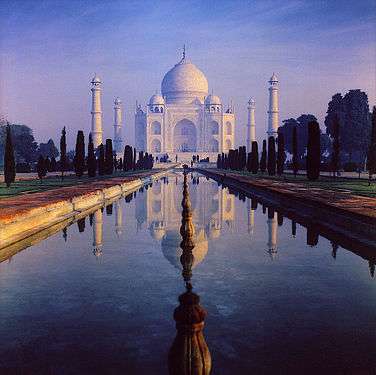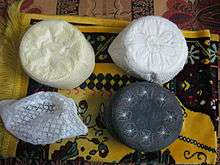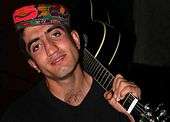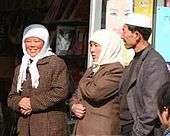Taqiyah (cap)
 |
| Part of a series on |
| Islamic culture |
|---|
| Architecture |
| Art |
| Dress |
| Holidays |
| Literature |
| Music |
| Theatre |
|
The taqiyah (also spelled tagiya; Arabic: طاقية / ALA-LC: ṭāqīyah, Turkish: "takke", Urdu, Hindi "topi"; ٹوپی / ALA-LC: “ṭopī”, Bengali: টুপি tupi) Somali "Koofi" is a short, rounded skullcap. They are often worn for religious purposes; for example, Muslims believe that Muhammad used to keep his head covered, therefore making it mustahabb (i.e., it is commendable to cover the head in order to emulate him).[1] Muslims often wear them during the five daily prayers.
When worn by itself, the taqiyah can be any color. However, particularly in Arab countries, when worn under the keffiyeh headscarf, they are kept in a traditional white. Some Muslims wrap a turban around the cap, called an amamah in Arabic, which is often done by Shia and Sufi Muslims. In the United States and Britain taqiyas are usually referred to as "kufis".[2]
Topi is a type of taqiyah cap that is worn in India, Bangladesh, Pakistan, and other regions of South Asia. Many different types of topi caps exist including, the Sindhi cap, worn in Sindh and the crochet topi that is often worn at Muslim prayer services, see salat.
The topi cap is often worn with salwar kameez, which is the national costume of Pakistan.
Etymology
Taqiyah is the Arabic word for a Muslim cap used in Saudi Arabia. In Pakistan and India, the prayer cap is called a topi. Topi means cap in the Hindi/Urdu language. In Pakistan, men usually wear the topi with salwar kameez. In Bangladesh it's known as tupi. In the United States and Britain, many Muslim merchants sell the prayer cap under the name kufi.
Muslim world
There are a wide variety of Muslim caps worn around the world. Each country or region usually has a unique head covering.
Countries
Afghanistan
In Afghanistan, men wear a wool beret called a pakol, which also refers to a cotton prayer cap. "Pakol" means taqiyah in the Pashto language spoken by the local Pashtun people. Salwar kameez is the traditional men's attire. However, among rebab players, the collarless shirt and pants called, payraan tumbaan or peran and tunban is popular. The Karakul (hat) is common. Additionally, women wear the burqa.
China
Men wear a white prayer cap with traditional Chinese clothing including the Chinese suit and a robe called a changshan. (See Islam in China). In the United States, the Chinese robe is sold as a men's cheongsam. For formal wear, the robe is made of silk, because silk is the traditional Chinese fabric. The rule of men not wearing silk for Muslims is ignored in China, because in China silk clothings are unisex while in the Arab world it is a feminene fabric.Cotton robes and kung fu suits are worn to jumu'ah. In China, the Hui people developed Muslim Chinese martial arts. Recently, the Chinese government has adopted the Tangzhuang as the national costume for men.
Indonesia
The peci/songkok is the national dress. In the United States, the songkok is called a rampuri cap or African fez cap. The Indonesians also produce a machine knitted skullcap that is popular with Muslims. Javanese people wear the sarong with their caps. In the United States, most Muslim merchants sell the sarong as an izar, izaar, or wizar.
Maldives
The prayer cap is called thakiha. The cap is known as the thofi and the fishermen cap is referred to as koari.
Bangladesh

The prayer cap in Bangladesh known here "Tupi". It's a category of Craft. Comilla, Nilphamary's Caps are imported in Middle east. It has a demand all over in Bangladesh.
Malaysia
Men wear the songkok. Traditional Malaysian men's attire consists of a shirt, matching pants, and waist wrap that is called a Baju melayu. For informal events, and prayers at the mosque, the sarong is worn. However, a person seen wearing a songkok in Malaysia, especially in a Dewan Undangan Negeri, is not necessarily a Muslim. This is because non-Muslims are required to wear one to comply with the dressing code of the assembly. Taqiyah is known as kopiah in Malaysia.
Pakistan
The prayer cap is called a topi, see Topi cap. Pakistani men wear a variety of other caps including the Sindhi topi, a mirrored cap with a front opening that allows the wearer to place the forehead on the ground during prayer, see Sindhi cap. Other caps include the karakul (hat), fez (hat), and pakol.
Russia
Muslim men wear the tubeteika. In Russia, the tubeteika is worn with a suit for Eid ul Fitr or Jumu'ah, and a tuxedo for wedding ceremonies. Russian Muslims also wear the doppa or rug cap. In Russia, giving a rug cap to a person as a gift is a sign of friendship. The Russian name for the doppa is tubeteika. In Russia, the folk costume consists of a kosovorotka for men and a sarafan for women. Among Turkic peoples, traditional Turkic costumes are worn. Russian Muslims wear a variety of fur hats including the karakul (hat), which is called an astrakhan hat in Russia, the ushanka, and the papakhi, see Islam in Russia. A Russian diplomat hat, which is a boat shaped cossack hat, is also worn. Nikita Khrushchev is said to have popularized it.
Somalia

Men in Somalia often wear the koofiyad cotton prayer cap, along with a sarong referred to as a macawiis. The jalabiya is also sometimes worn.[3]
Sudan
The prayer cap is worn under a white turban called an imama. Sudanese men wear the white turban with a white thobe called a jalabiyyah, see Islam in Sudan and Culture of Sudan. In the United States, the Sudanese robe is sold as an African dishdasha, Sudani, or Sudanese thobe.
Turkey
Before 1925, men used to wear the fez hat and calpack, or a conical taqiyah known as the taj. However, the hat law of 1925 formally banned these form of hats. The Turkish cap, which is similar to a beanie or tuque, can also commonly be found. The Turkish cap is made of wool or cotton fleece and has a distinctive pom-pom or toorie on top. Turkish people also wear regular cotton prayer caps. Women wear a variety of folk dresses with a vest called a jelick and a veil called a yashmak. The traditional wedding dress is red. Men wear the folk costume to festivals and prayers, but most men don a suit or tuxedo for weddings. Additionally, Dervishes have a unique costume.
United Arab Emirates
Men in the UAE often wear the koofiyad cotton prayer cap. Emirati men wear the white Koofiyad with a white thobe called a jalabiyyah or Dishdasha. In an effort to strengthen religious awareness for foreign visitors, Sheik Mohammed Bin Rashid Al Makthoum the crown prince of Dubai has, from 2012 onwards, requested that all visiting westerners and non-Muslims adhere to Islamic dress code during religious festivals. If full adherence is impossible a simple Koofiyad worn during prayers will suffice.
Regions
Central Asia

The doppa is most common. In the United States, the doppa is sold as an Uzbek kufi, Bukharan kippah, Bucharian, or Bokharan yarmulke (Bukharian Jews of Central Asia also wore headcoverings similar to the Doppi/Tubeteika design but wore it for religious reasons pertaining to Judaism). The doppa is also called the rug cap because the needle work is the same as that found on Uzbek oriental rugs, see Uzbek people. In Central Asia, men wear the doppa with a suit. Uzbeks also wear the tubeteika, which they call a duppi. The traditional tubeteika is a black velvet cap with white or silver embroidery. For festivals, a folk costume is worn that consists of a robe called a khalat. The khalat is often worn with a coat called a chapan. Tajiks wear the rug cap and the tubeteika. In Canada, Neil Peart, the drummer for Rush, wears a tubeteika. Also, followers of the Naqshbandi Haqqani Sufi Order wear Uzbek Kufis as Bahauddin Naqshband was from Uzbekistan and it is seen as a friendlier alternative to the austere solid black and white of some Muslims.
Eastern Europe
The Bosniaks wear the cotton prayer cap, the black beret, and the fez hat, see Islam in Bosnia and Herzegovina. During Eid ul Fitr, the prayer cap is worn with a suit. For wedding ceremonies, a tuxedo is worn.
North Africa

The fez hat, the tarboush or chechia is worn. In Morocco, men wear the djellaba with their fez hats. The short sleeved robe is the gandora. In Egypt, the galabeya is worn.
Southeast Africa
The kofia is commonly worn in the Muslim communities in the coastal areas of Kenya, Tanzania, and Uganda. Some Swahili speaking populations that are Muslim wear the kofia with a white robe called a kanzu in the Swahili language. In the United States, the kanzu is sold as an Omani thobe, Emirati thobe, or Yemini dishdasha. A white kanzu and suit jacket or blazer is the formal wear of Swahili peoples.
West Africa
There is the kufi, which is worn with the grand boubou. The West African robe is called a Senegalese kaftan. The traditional wedding attire is the dashiki suit. The traditional women's attire is the kaftan or the wrapper.
Western converts
Most converts use the name Kufi when referring to a prayer cap. Many converts wish to keep the clothing of their culture, as a Muslim may wear any clothing items as long as they are modest.
Many western converts to Islam will wear their own cultural clothes to Islamic services. For instance, a Scottish man would wear a kilt and perhaps a taqiyah for his wedding instead of the Balmoral bonnet. English men would wear morning dress and the taqiyah, instead of the top hat. Western clothing, like trousers and an oxford shirt, or a suit, would be worn with the taqiyah to Friday prayers. An Irish man may chose to wear an Aran sweater or a Grandfather shirt with his taqiyah to Friday prayer services. A French man would wear a and a beret or a taqiyah to Friday prayer services. Depending on where they come from, some Hispanic Americans would wear a Guayabera shirt, Khaki pants and Dress shoes. The clothing must be modest. For example, a German man would not wear Lederhosen to Friday prayer services, because the shorts are immodest, see Awrah.
Some converts choose to adorn what is seen as traditionally Muslim clothing to the Mosque and worship services. A man may wish to wear a long robe (thobe) or Shalwar Kameez. A man from the Naqshbandi-Haqqani Sufi Order may wear a Long Turkish Shirt, vest called Haydariye and baggy pants with a Turban when going to Zikr events, this is very common for western converts in that Sufi Order as the shirt and pants blends in with common western clothing better than more conspicuos Islamic dress.
See also
- Dhaka topi
- Fez
- Islam and clothing
- Keffiyah
- Kippah – hat worn by Jewish males
- Kufi
- List of hats
- Pakol
- Sindhi cap
References
- ↑ Shaykh Muhammad Hisham Kabbani (1998) Questions on Islamic Dress and Head-dress for Men sunnah.org
- ↑ Osbourne, Eileen (2005). RE - Buildings, Places and Artefacts A Teacher Book + Student Book (SEN) (11-14). Folens Limited.
- ↑ Michigan State University. Northeast African Studies Committee, Northeast African Studies, Volume 8, (African Studies Center, Michigan State University: 2001), p.66.
External links
| Wikimedia Commons has media related to Taqiyah. |
| Wikimedia Commons has media related to Topi. |


